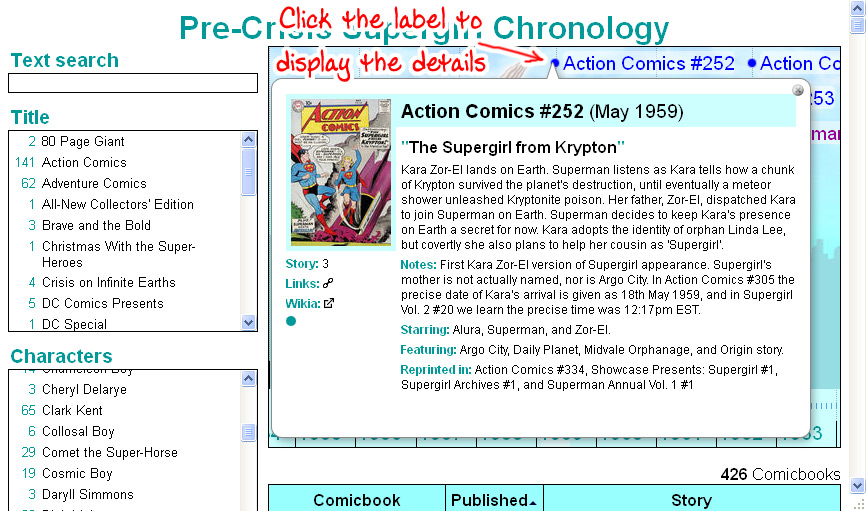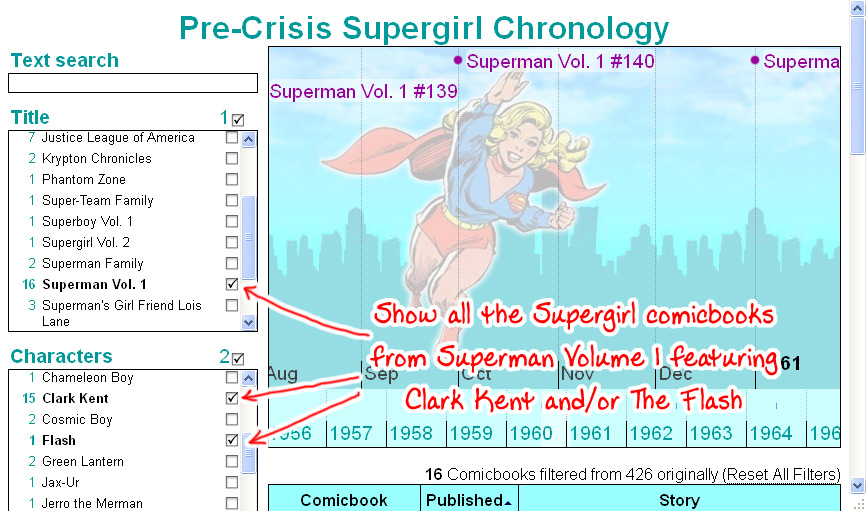Q: How do these pages work?
The chronology is broken up into published eras: the Classic Kara Zor-El pages deal with
Pre-Crisis stories published from 1959 to the late 1980s, corresponding closely to the original
classic Kara Zor-El character. The Matrix and Cir-El pages deal with stories from the 1990s
to the early 2000s, corresponding closely to the Matrix, Linda Danvers, and Cir-El, characters.
Each chronology comes in two forms: a scrolling timeline view, and a list view —
both views use the same data. The controls in the left-hand column dynamically redefine what data
the page displays (this might take a couple of seconds.) The timeline view can be dragged to scroll
forward or backward in time — dragging the lower band will scroll faster. Clicking an entry
on the timeline or list displays the issue details.
The page contents are interconnected: selecting Clark Kent from characters
category not only rebuilds the main area to show only his appearances, but adjusts the other
filters to show the appropriate years and reprints. The images below demonstrate
how this works.
Q: What information sources were used to create these pages?
In all cases the main story description and notes are written specifically
for this chronology, focusing on Supergirl's role in the story rather than detailing the overall plot.
The issue list used to create the Classic Kara Zor-El Era pages was created largely from the
author's own collection, complimented by fan web sites and online encyclopaedias that detailed cameo
or rare appearances. In a handful of cases the Grand Comics Database
and the DC Comics wikia database were used to
confirm creator details.
The issue list used to create the Matrix Era pages came initially from the
Supergirl Maid of Might fan web site, complimented
by online articles and other sources to fill in obscure appearances not included by SMoM.
The creator details and reprint details came from the Grand
Comics Database. Some other details, such as story titles, were taken from the GCDB, but heavily
edited or amended. The DC Comics wikia
database was also used to verify a handful of details.
Q: What issues are missing, and why?
The chronology covers all known DC Comics issues with stories featuring the
character Supergirl across her numerous incarnations. This includes full appearances, cameos, and
reprints. The chronology does not include out-of-story appearences, such as adverts,
editorials, and profiles.
For convenience the chronology is broken up into published eras which closely map to distinct
periods in Supergirl's history. Naturally the mapping isn't perfect, as authors occasionally write
stories involving Supergirls from the past. Some stories that involve the Pre-Crisis Supergirl,
for example, were written and published long after Crisis on Infinite Earths. These stories will
be documented based on when they were published, not which period of Supergirl's history they are
set in or based on.
Below are lists of stories that were published outside of the period to which the featured
Supergirl belongs, and notable appearances that are not inside a story:
- Classic Kara Zor-El era issues, published after 1988:
- Legends of the DC Universe: Crisis on Infinite Earths #1 (Feb 1999)
— supposed missing episode from Crisis on Infinite Earths.
- Supergirl Vol. 4 #75 (Dec 2002)
— start of the Many Happy Returns storyline.
- Supergirl Vol. 4 #76 (Jan 2003)
— Many Happy Returns storyline.
- Supergirl Vol. 4 #77 (Feb 2003)
— Many Happy Returns storyline.
- Supergirl Vol. 4 #78 (Mar 2003)
— Many Happy Returns storyline.
- Superman vs. Darkseid: Apokolips Now (Mar 2003)
— Many Happy Returns storyline.
- Supergirl Vol. 4 #79 (Apr 2003)
— Many Happy Returns storyline.
- Supergirl Vol. 4 #80 (May 2003)
— end of the Many Happy Returns storyline.
- DC: The New Frontier #6 (Nov 2004)
- Solo #1 (Dec 2004)
- Solo #7 (Dec 2005)
- Superman / Batman #24 (Jan 2006)
- Superman / Batman #25 (May 2006)
- Justice #8 (Dec 2006)
- Justice #10 (Apr 2007)
- Justice #11 (Jun 2007)
- Justice #12 (Aug 2007)
- DC Universe Legacies #5 (Nov 2010)
— cameo.
- DC Retroactive: Superman -- The 70s (Sept 2011)
- DC Retroactive: Superman -- The 80s (Oct 2011)
- Classic Kara Zor-El era non-story appearences:
- Adventure Comics #365 (Feb 1968)
— First ever usage of name "Kara Zor-El" in feature on Legion of
Super Heroes.
- Matrix and Cir-El era issues, published after 2004:
- Superman / Batman #24 (Jan 2006)
- Superman / Batman #25 (May 2006)
- JLA: Classified #45 (Dec 2007)
- Reign in Hell #1 (Sept 2008)
— Linda Danvers appears in 'Sundered Dominion' strip.
- Reign in Hell #6 (Feb 2009)
— cameo.
- Reign in Hell #7 (March 2009)
— cameo.
- Matrix and Cir-El era non-story appearences:
- JLA in Crisis Secret Files #1 (Nov 1998)
— Supergirl appears in profile page only.
- Legends of the DC Universe 3-D Gallery #1 (Dec 1998)
— single page gallery appearence
(pencils: Leonard Kirk, inks: Wayne Faucher, colors:Tom McCraw.)
- Secret Files & Origins Guide to the DC Universe 2000 #1 (Mar 2000)
— Supergirl appears in a profile page only.
- Superman: Our Worlds at War Secret Files #1 (Aug 2001)
— Supergirl appears as part of a crowd, on a page profiling
Superman's Earth allies.
- Superman / Batman Secret Files 2003 #1 (Nov 2003)
— Cir-El appears in a two page spread profiling the
Superman / Batman families.
Q: What do the symbols and shorthand mean?
Some symbols denote the type of appearance:
 indicates the issue contains
a full appearance;
indicates the issue contains
a full appearance;  indicates
the issue contains a cameo, where the Girl of Steel doesn't play any real part in the
plot;
indicates
the issue contains a cameo, where the Girl of Steel doesn't play any real part in the
plot;  indicates the issue contains a reprint. If an issue has more than one story, more than
one symbol may appear for that issue.
indicates the issue contains a reprint. If an issue has more than one story, more than
one symbol may appear for that issue.
Other symbols denote the type of reprinted material:
(R) indicates a basic reprinted story, exactly as the original
apart from colors (reprinted stories were often recolored from the original ink
artwork); (RT) indicates a reprint was retitled, but otherwise
unchanged; (R-) indicates a partial reprint, where material
has been edited out of a story, or only one page has been reproduced.
Plus there are symbols that denote the portion of the story Supergirl appears in:
(pt2) (for example) indicates this 'story' is actually
chapter two or part two of a bigger story that spans the issue.
Q: What are the tropes?
The Silver Age was a crazy time, and there were a lot of themes and plot ideas frequently reappear.
- Car over a cliff: Wherever Linda Lee Danvers lived there was
always a dangerous mountain path or a rickety bridge for cars to fall off. This
became quite a recurring theme over the years, with the Girl of Steel frequently
having to swoosh down and drab the falling vehicle.
- Flying vehicle: As well as rescuing cars falling from the
side of cliffs, Supergirl was also prone to picking up non-flying vehicles and
zooming through the air with them like a toy.
- Freak transformation: Red Kryptonite and magic
frequently transformed the Girl of Steel (and other characters) into a monster or
some other form of freak. The effects usually wore off, eventually.
- Imaginary tale: Once in a while the writers would
spin a fantastical yarn, only to reveal it was a dream or an imaginary
story at the end.
- Interchangeable female: Particularly in the 1960s,
one female character could often pass as another simply by using a wig
or parting her hair differently. We're not talking about a proper
disguise, or a dual identity (like Linda and Supergirl), but the idea
that Lois Lane could pass as Supergirl (even in front of Superman) by
merely wearing a blonde wig. The idea of the interchangeable female is
that all females are effectively clones, distinguishable only by their
hairstyle.
- Memory loss: Sometimes, particularly with time
travel stories, it was convenient for Supergirl to have her memory
of the story's events wiped at the end. Often super villains would
tamper with the Girl of Steel's memory too.
- Mind control: Occasionally Supergirl would become
possessed or controlled by other people, or aliens, or magic, or Red-K.
- Origin retcon: From time to time the writers would
retell Supergirl's origin story, but with added little details (that
worked with the current story.)
- Romance: Quite often Supergirl would fall head-over-heels
in love with someone, usually a visiting alien passing themselves off as
a student at Stanhope College.
- Secret identity problems: Supergirl didn't always
succeed in protecting her secret identity, and sometimes she would have
trouble getting away so she could transform into costume.
- Super power loss: Because Supergirl is so powerful,
the writers had to devise interesting ways of de-powering her to
introduce elements of peril and challenge into the stories. This
category excludes visits to Kandor (where all Kryptonians are powerless)
unless the story involves action sequences while powerless.
Q: The Semantic what..!?
Okay, here the technical bit: the Semantic Web, sometimes known as Web 3.0, was
pioneered by Sir Tim Berners-Lee and MIT as a way of constructing heavily data-driven
web pages that can reshape their contents around visitor interactions. When a visitor
selects an item on a semantic page, the connections from that item to other items on the page
are traced, and the page can be reshaped and filtered based on those relationships.
Like a lot of ideas, it's hard to explain on paper but easy to understand once you
play with a live example.
This Supergirl Chronology uses the experimental
Simile Exhibit toolkit developed
by the researchers at MIT's CSAIL, which provides
a simple lightweight framework for creating Semantic Web pages from compact datasets.








